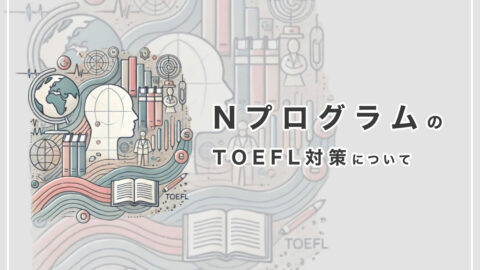こんにちは、SOLO IELTS TOEFLのルークです。
TOEFL Integratedライティングの疑問提示型問題の対策について解説します。
20点前後の壁にあたっている人は参考になると思います
目次:
Integrated ライティング対策
TOEFL iBT Integratedはライティングする前に、読み聴きをする必要があります。そのためIntegratedという呼び名になっています。
具体的には、3分でパッセージを読み、それに関するレクチャーを聴き、ライティングでまとめるといったものです。
Integratedライティングは2つの問のパターンがあります。
- パターン1: 疑問提示型問題
- パターン2: 例で補足説明型
この記事では疑問提示型の問題の対策について述べていきます。
出題される確率はパターン2よりも高いです。
疑問提示型の特徴としては、レクチャーがパッセージの内容に関して、矛盾もしくは疑問を呈する形で展開していくことです。
Integratedは特にリスニング力が鍵を握るタスクですね
ストラクチャー
Integratedライティングの基本的なストラクチャーは問のパターンに関わらず以下です。
- 導入
- ボディ1
- ボディ2
- ボディ3
- 結論
リーディングでもリスニングでもポイントが3つ挙げられます。それをボディ1-3と分けて展開して書いていきます。
テンプレート
TOEFL Integratedライティングの疑問提示型の問は以下のようなテンプレートになります。
各パラグラフにリーディングとリスニングのポイントを1つずつ挿入していきます
導入
The reading and the lecture are both about ___. Whereas the author of the reading states that ___, the lecturer suggests that___.
The lecturer casts doubts on the main points made in the reading by providing two/three reasons.
ボディ1
First of all, according to the reading, ___.
However, the lecturer disputes this point.
He says that___.
(Optional) Furthermore, he/she mentions that ___.
ボディ2
Secondly, the reading states that ___.
Nevertheless, the lecturer refutes this argument.
He/She argues that ___.
(Optional) In addition, he/she points out ___.
ボディ3
Finally, the reading claims that ___.
On the other hand, the lecturer believes that___.
He/She thinks that___.
(Optional) Moreover, he/she feels that ___.
結論
In conclusion, although the reading and the lecture are both about___, the two/three main points made in the reading are effectively challenged by the lecturer.
ポイントとなる語句は、cast doubt on / refute / disputeの3点です。
レクチャーでは反対の立場をとるためこういった語彙を使用して展開すると見栄えがよくなります。
メモの取り方
リーディングのパッセージを読む際と、レクチャーを聞く際のメモの取り方について確認しましょう。
パッセージ、レクチャー双方とも、 筆者のポジションとメインアイデア3点をメモするようにします。
レクチャーでは通常ポジションに関しては冒頭で述べられることが多いです。後続に列挙される例と、反対意見をきちんと書き取れるかどうかがキーになります。
レクチャー内ではパッセージに含まれていない関係のない情報が出てきますので、ライティングに含めないように気をつけましょう
練習問題
それでは問題提示型のInteratedライティングの練習問題を解いてみましょう。
きちんとメモをとるように心がけてください。
READ A SHORT PASSAGE 3分
Sea otters are a small mammal that lives in the waters along North America’s west coast from California to Alaska. A few years ago some of the sea otter populations off of the Alaskan coast started to decline rapidly and raised several concerns because of their important role in the coastal ecosystem. Experts began investigating and came up with two possible explanations. One explanation was environmental pollution and the second was attacks by predators.
At first it seemed as if the pollution was the most likely cause for the population decline. One reason pollution was more likely was because of the known pollution sources along the Alaskan coast such as oil rigs. Also water samples taken in the area showed increased levels of chemicals that could decrease the otters’ immune systems and indirectly result in their deaths.
Another thing that pointed to pollution as the culprit was the decline of other sea mammals such as seals in the same areas. This indicated that whatever was affecting the otters was also affecting the other sea mammals. Environmental pollution usually affects an entire ecosystem instead of just one species. Only predators that occurred in a large area, such as orcas (a large predatory whale), could cause the same effect, but they usually hunt larger prey.
Finally, scientists believed the pollution hypothesis would also explain the uneven pattern of otter decline. In some Alaskan locations the otter population declined greatly while other populations remained stable. Some experts suggested this could be explained by ocean currents, or other environmental factor, might have created uneven concentrations of pollutants along the coast.
メリット3つをきちんとメモできましたか?
反対となるアイデア3つを聞き取れたかがポイントになります
問: Summarize the point made in the lecture and explain how the speaker cast doubt on specific points made in the reading passage.
モデルアンサー
それでは以下にテンプレートにそったモデルアンサーをのせていますので確認してください。
赤字の部分がテンプレです
The reading and the lecture are both about the decline in sea otter populations. While the reading’s author states that pollution is a cause of their populations declining, the lecturer suggests that the greatest factor is predation. The lecturer casts doubts on the main points made in the reading by providing three reasons.
First of all, according to the reading, higher levels of pollutants in water samples support the pollution theory. However, the lecturer disputes this by explaining that if sea otters had been killed by pollutants in water, their remains would appear on shores, which indicates predators ate the sea otters.
Secondly, the reading states that populations of other small sea animals have been hurt by pollution. Nevertheless, the lecturer refutes this argument. He argues that because the whale population decreased, nearby orcas had to eat otters instead.
Finally, the reading claims that pollutant concentration can explain the uneven pattern of diminishing sea otter populations. On the other hand, the lecturer believes that this uneven population decline corresponds with the prevalence of orcas in different areas. He thinks that the otter population declines more in places with orcas, and less in those inaccessible to orcas.
In conclusion, although the reading and the lecture both concern hypotheses about diminishing sea otter populations, the three main points made in the reading are effectively challenged by the lecturer.
いかがだったでしょうか?驚くことに半分以上がテンプレートです。
Integratedライティングはもはや読み、聴きのテストに近いと言われる由縁です。
まとめ
TOEFL Integratedライティング「疑問提示型」問題のコツは掴めましたか?
Integratedライティングはきちんと3つのポイントを読めて聴けて、このフォーマットでかけば高スコアがでます。
逆に20点そこらで停滞している人の多くがポイントを1,2個しか抜き出せていません
次の記事: 【補足説明型の問題対策】TOEFL ライティング
最短で伸ばすならSolo
SoloはTOEFLのスコアを最短で伸ばします。
自分だけで学習できる自信がない人は是非一度カウンセリングに来てみてね。
弊社のTOEFLのプロ講師たちが待ってるよ。











